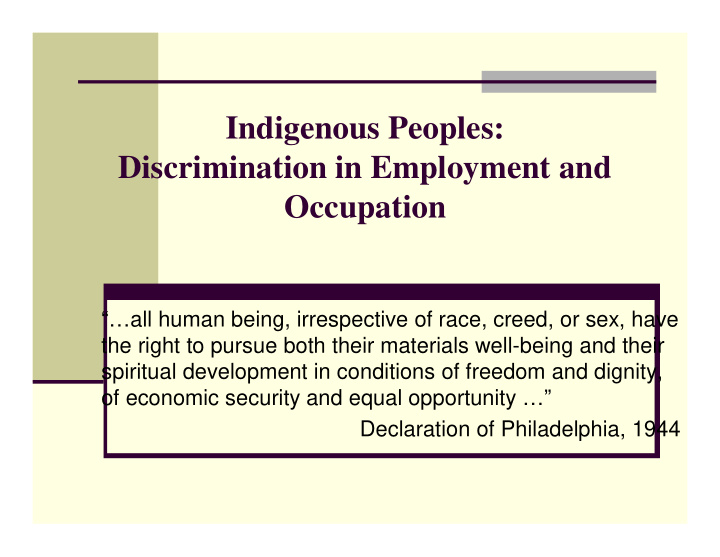



Indigenous Peoples: Discrimination in Employment and Occupation “…all human being, irrespective of race, creed, or sex, have the right to pursue both their materials well-being and their spiritual development in conditions of freedom and dignity, of economic security and equal opportunity …” Declaration of Philadelphia, 1944
Discrimination against indigenous peoples: � They have lost control over their development path through historical processes; � Are often excluded from political participation; � Traditional economies and occupations are undermined due to lack of control over land, territories and resources � Most face high levels of poverty � Indigenous women face additional gender- based marginalization and discrimination.
Discrimination against traditional occupations � Marginalization though land grabbing, large scale development project, population transfer, protected areas, etc. � Decision-makers are often unaware of importance of traditional occupation for poverty reduction and sustainable development � Traditional occupations (e.g. shifting cultivation, pastoralism) are disregarded or even prohibited by state law. � Lack of investment, infrastructure and social services, as well as poor access to market and credit � Lack of reliable data and statistics
Discrimination in employment � Disadvantaged with regards to access to education, vocational training and formal employment… � Social services are often inadequate to their needs � Their knowledge and skills (e.g. of indigenous languages) not valued in the labour market � Mostly employed in informal sector; low wages, and no social protection mechanisms. � Disproportionately represented among victims of child labour, forced labour etc..
Results of discrimination � Widespread malnutrition, poor educational results, health problems, increasing poverty, unemployment or underemployment. � Widespread out-migration from indigenous lands � Destruction of social fabric and cultural institutions � Represent 5% of world’s population but 15% of the World’s poor (WB)
ILO Convention No. 111 on Employment and Occupation � Adopted in 1958 upon request by the UN � First non-discrimination treaty. � Fundamental ILO Convention and main ILO instrument on discrimination � Closely related to the provisions of other human rights treaties concerning equality and work (e.g. right to work, article 6 of ICESCR) � 166 ratifications as of August 2008
Objective � Promotion of equality of opportunity and treatment in employment and occupation, with a view to eliminating discrimination � Covers all workers and all sectors of employment, including self-employment and non-wage work
What kind of discrimination? � The Convention addresses discrimination based on � Race, colour and national extraction, including ethnicity/indigenous origin or identity � Sex � Religion � Political opinion � Social origin
Definition: � any distinction, exclusion or preference…, � which has the effect of nullifying or impairing equality of opportunity or treatment � in employment or occupation
What is meant by “employment and occupation”? � Access to vocational training � Access to employment and particular occupations (including traditional occupations) � Occupation means the trade, profession or type of work performed irrespective of branch of economic activity or professional status � Terms and conditions of employment
What is not discrimination? � Distinctions based on inherent job requirements � Special measures of protection and assistance � Measures affecting an individual who is suspected of or engaged in activities prejudicial to the security of the State
Special measures � Special measures of protection and assistance are not deemded to be discrimination � Special measures provided for in ILO standards (e.g. C.107 and C.169) � Special measures introduced at the national level designed to meet requirements of certain workers (e.g. based on sex, disability, age, family responsibilities, or social or cultural status)
Indirect discrimination � Apparently neutral law, policy or practice which has a disproportionate negative impact on a particular group protected by the Convention or by national legislation, and which has no objective job-related justification
Challenges � National laws often emphasize “formal equality” � Equality often seen exclusively as an individual human right � The laws providing protection from discrimination tend to cover the formal economy � Convention No.111 gives Governments latitude to decide what measures to implement are appropriate � Weak enforcement mechanisms
Opportunities � Measures taken to apply the Convention must be effective: � Mainstreaming equality concerns into national development policies � Concept of indirect discrimination � Special measures (art. 5) � Cooperation with “other appropriate bodies” (art. 3(a)) � Respect principles of ILO Convention No.169
Recommend
More recommend